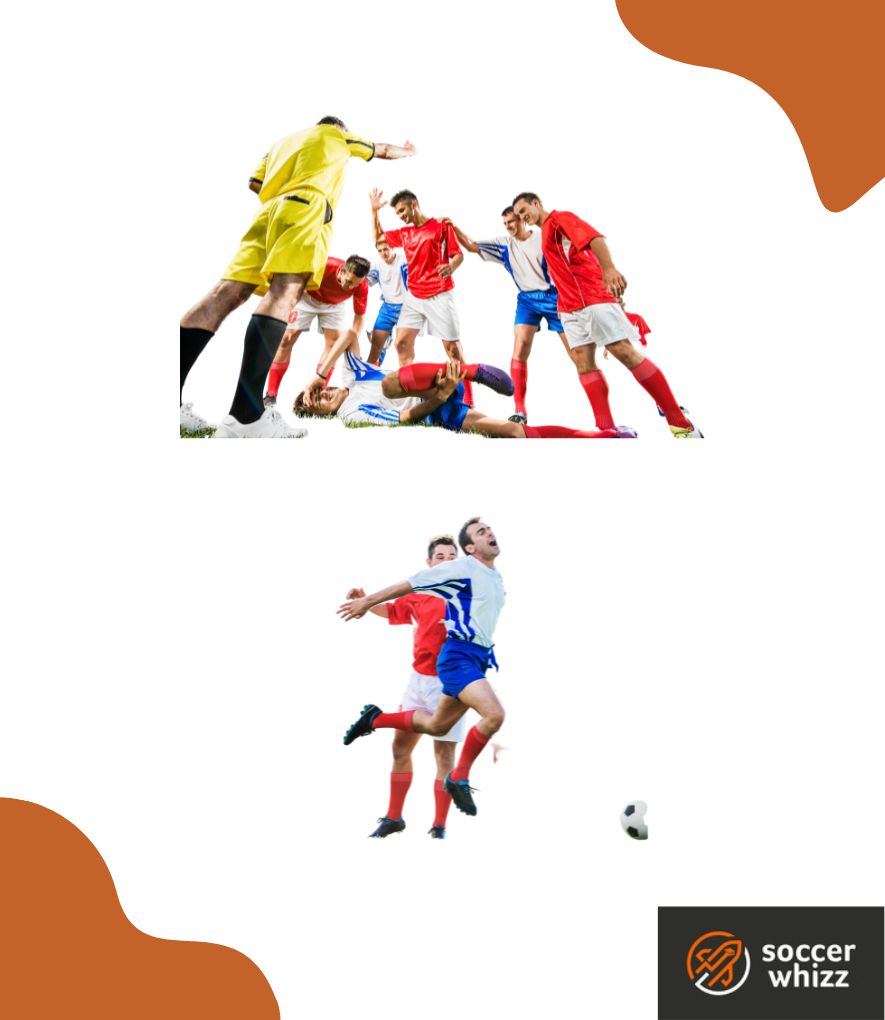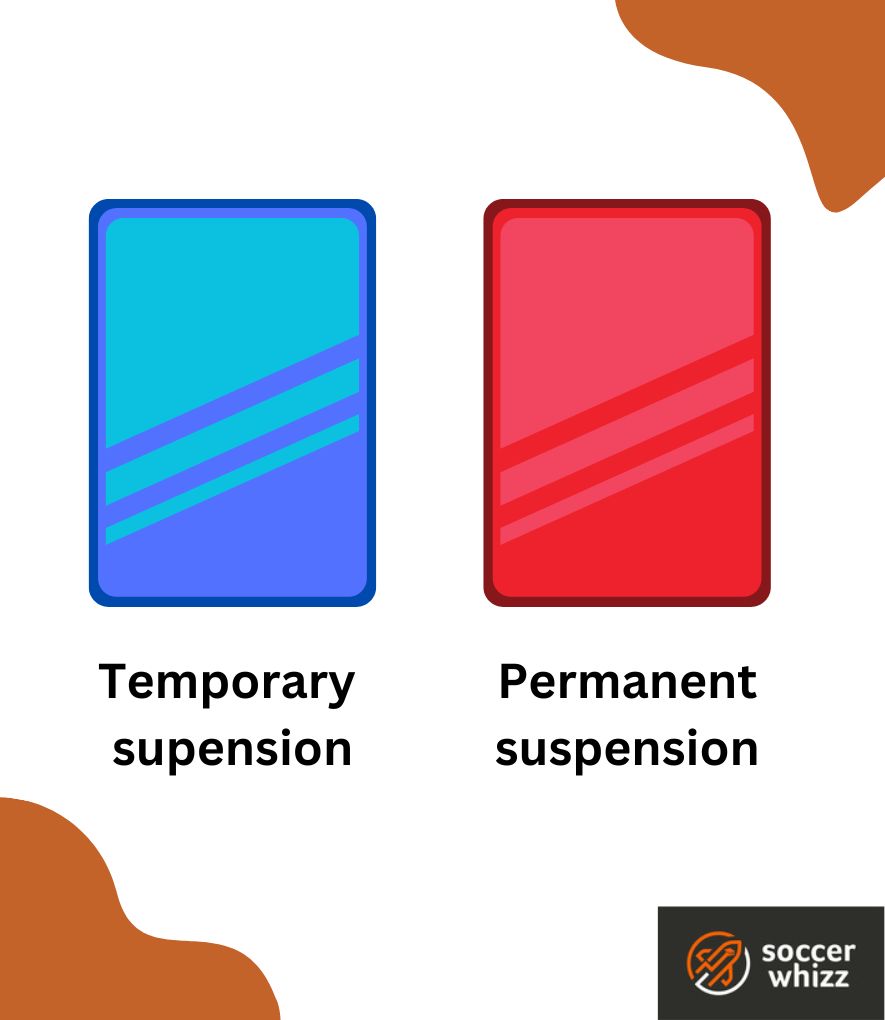In the dynamic realm of soccer, where moments of triumph and controversy often intertwine, a new addition to the referee’s arsenal has emerged – the enigmatic blue card.
Challenging traditional norms and aiming to redefine the concept of fair play, the blue card has swiftly made its mark, sparking curiosity and igniting passionate debates among players, fans, and pundits alike.
Traditionally, soccer has been governed by a system of disciplinary actions mainly comprising of yellow cards and red cards.
However, the introduction of the blue card adds a new dimension to the spectrum of penalties, focusing specifically on infractions of a tactical or persistent nature, while maintaining a fair balance between player safety and the flow of the game.
Here’s a quick definition of what this term is…
The blue card in soccer is a minor penalty where an offending player sits in a penalty box area due to being temporarily suspended from match play, either for a duration of two minutes or until a goal is scored against the offending player’s team.

Read on to learn more about this unique refereeing punishment present in some forms of the beautiful game.
- When were blue cards introduced into the game?
- Which offences can a player commit to get a blue card in soccer?
- What are the consequences of receiving a blue card during a match?
- Are blue cards restricted to indoor soccer games?
- How is a blue card different from other cards in soccer?
- Concluding thoughts
When were blue cards introduced into the game?
Blue cards have been unofficially introduced into soccer in various grassroots and youth initiatives as an alternative disciplinary measure to traditional yellow and red cards.
While there is no specific date or widespread adoption at the professional level, the concept of blue cards has gained attention and experimentation in recent years.
Blue cards are relatively infrequent in the realm of soccer, primarily finding their application within the context of indoor soccer when addressing instances of misconduct.
Specifically reserved for indoor soccer, the blue card serves as a distinct symbol of disciplinary action in this particular variant of the sport.
Which offences can a player commit to get a blue card in soccer?
In the context of indoor soccer, the referee utilizes a blue card to caution players for engaging in minor offenses, collectively termed as “unsporting behaviors.”
These unsporting behaviors encompass a range of transgressions that can disrupt the flow and fairness of the game.

One particular instance of the blue card being called into use during a game was when a player deliberately used his or her hands to prevent a goal scoring opportunity.
Here’s a quote from a reputable news outlet to this effect:
“The blue card is a third penalty card referees have been carrying this season in addition to the yellow and red. According to the FHSAA soccer manual, there is only one instance a blue card should be used: when a player uses his or her hands to prevent a goal-scoring opportunity. The offense was previously issued a red card, which resulted in the player being ejected and suspended for up to a week (two games). The team could not substitute for that player. With the blue card, the penalty is less severe. The player is disqualified from the game but is not subject to a suspension. The team is still not allowed to substitute.”
Source – Tampa Bay Times
Some other examples unsporting behavior that bring the blue card into action include:
- Continuous infringements;
- Violations of safety rules;
- Dissent through words or actions;
- Illegal substitutions;
- Minor physical fouls;
- Spitting on the turf;
- Encroachment; and
- Exceeding the permissible number of players on the field
By brandishing the blue card, referees aim to maintain control and uphold the integrity of the indoor soccer match, ensuring that players adhere to the required standards of sportsmanship.
What are the consequences of receiving a blue card during a match?
When a player receives a blue card during an indoor soccer match, there are specific consequences that follow.
Here are some of the typical outcomes:
Temporary suspension
With this type of consequence, the player must serve a temporary suspension, usually lasting for a specified duration, typically around two minutes.
Power play
During the player’s suspension by way of a blue card, the opposing team benefits from a numerical advantage, creating a power play scenario where the opponent outnumbers the team affected with the temporary sending off.
Team adjustment
Another point to note is that the affected player’s team must adapt tactically and make adjustments to compensate for the temporary loss.
This could involve a player switching position or adapting their role to compensate for the absence of their team mate.
Are blue cards restricted to indoor soccer games?
Blue cards are primarily associated with indoor soccer games.
They are commonly used as a disciplinary tool in indoor soccer to address minor offenses and unsporting behavior.
The use of blue cards is more prevalent and widely recognized in indoor soccer compared to outdoor soccer.
In outdoor soccer, the traditional yellow and red cards are the standard means of issuing cautions and dismissals to players.
While blue cards are primarily restricted to indoor soccer, it’s worth noting that their implementation can vary depending on the specific rules and regulations of different leagues, tournaments, or regions.
How is a blue card different from other cards in soccer?
A blue card in soccer differs from other cards, such as yellow and red cards, in terms of its purpose and application.
Here are the key distinctions:
1. Offense severity
Yellow and red cards primarily deal with more serious infractions and misconduct, often resulting in player warnings, cautions, or dismissals from the game.
In contrast, blue cards are typically reserved for minor offenses or unsporting behaviors that do not warrant immediate player expulsion.
2. Temporary sanction
While yellow and red cards can lead to immediate consequences, such as player ejection or suspension for subsequent matches, a blue card usually results in a temporary suspension of the player.

This temporary suspension typically lasts for a specific duration, usually around two minutes, during which the penalized team must play with a numerical disadvantage.
3. Indoor soccer emphasis
Blue cards are primarily associated with indoor soccer.

They are used in this specific variant of the game to address misconduct and maintain discipline during matches played in indoor arenas.
4. Contextual limitations
Blue cards are not universally recognized or implemented in all soccer competitions, especially outdoor soccer.
They have gained more prominence and acceptance in indoor soccer leagues and tournaments, where they serve as a specific disciplinary tool.
Concluding thoughts
Overall, the blue card in soccer stands as a distinctive disciplinary measure, specifically employed in indoor soccer to address minor infractions and unsporting behavior.
Its introduction brings fresh perspectives to maintaining fair play, while acknowledging the need for proportionate consequences.
As soccer continues to evolve, the concept of blue cards invites further reflection on how disciplinary measures can adapt to ensure the game remains competitive, enjoyable, and true to its spirit.
If you’ve enjoyed this brief read, then you’ll probably be just as excited to learn more about what a green card in soccer represents or what a white card means in the context of soccer.
If you enjoy the content that I create and would like to buy me a coffee, then I’d really appreciate it!
Any money that I earn through this donation will be re-invested into more content for this website.
Additionally, by sending in a donation you’ll also receive a copy of my recently released 190+ page eBook on Soccer Ball Care, as well as be subscribed to our mailing list where you’ll be regularly informed on the latest developments concerning the Soccer Whizz blog.
- Future Icons: Europe’s Emerging Midfield Maestros Set for Glory - December 4, 2023
- Kickstarting a Revolution: How Soccer Transformed the United States Over the Last Four Years - October 7, 2023
- 4-1-4-1 Soccer Formation [Analysis] - September 23, 2023

